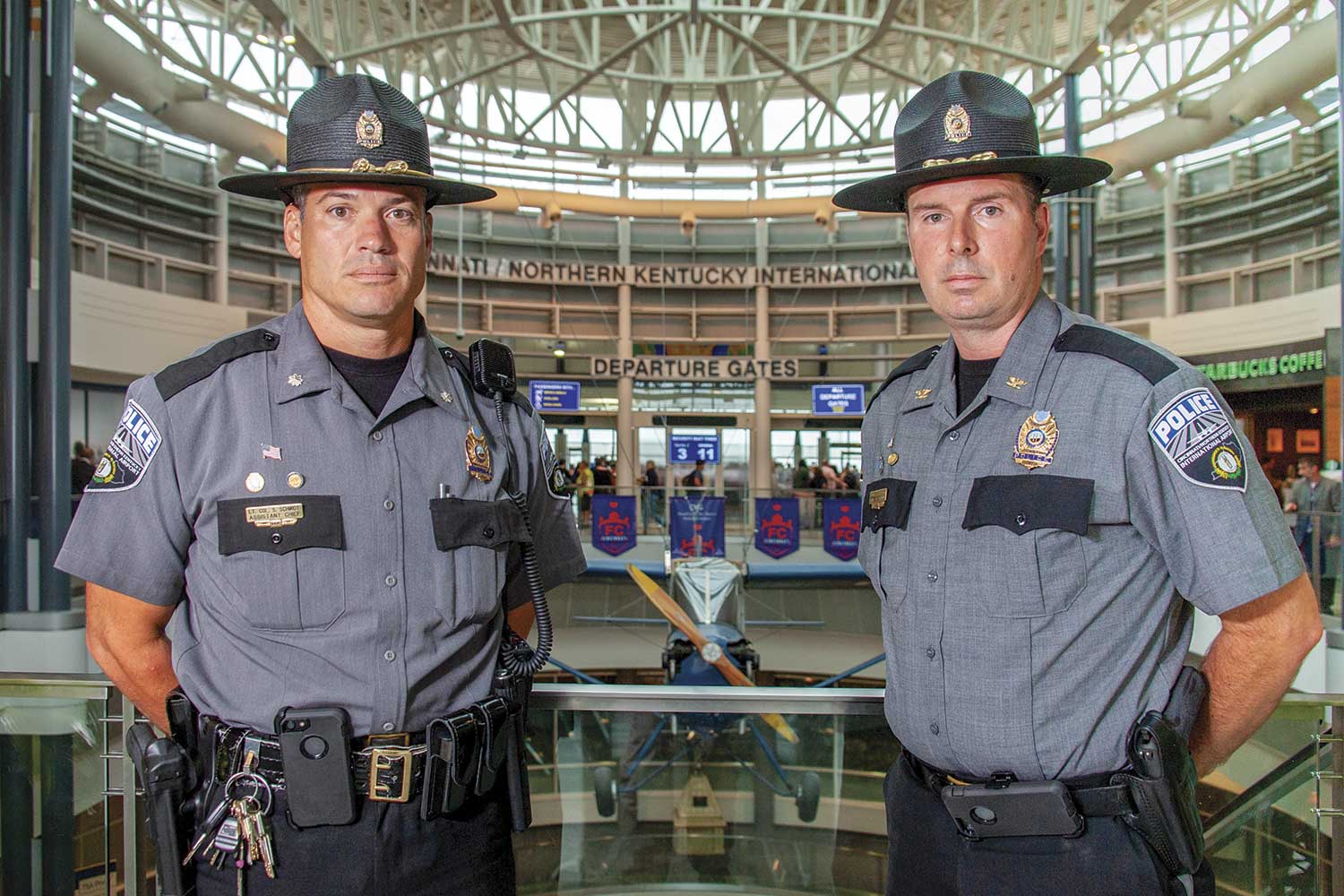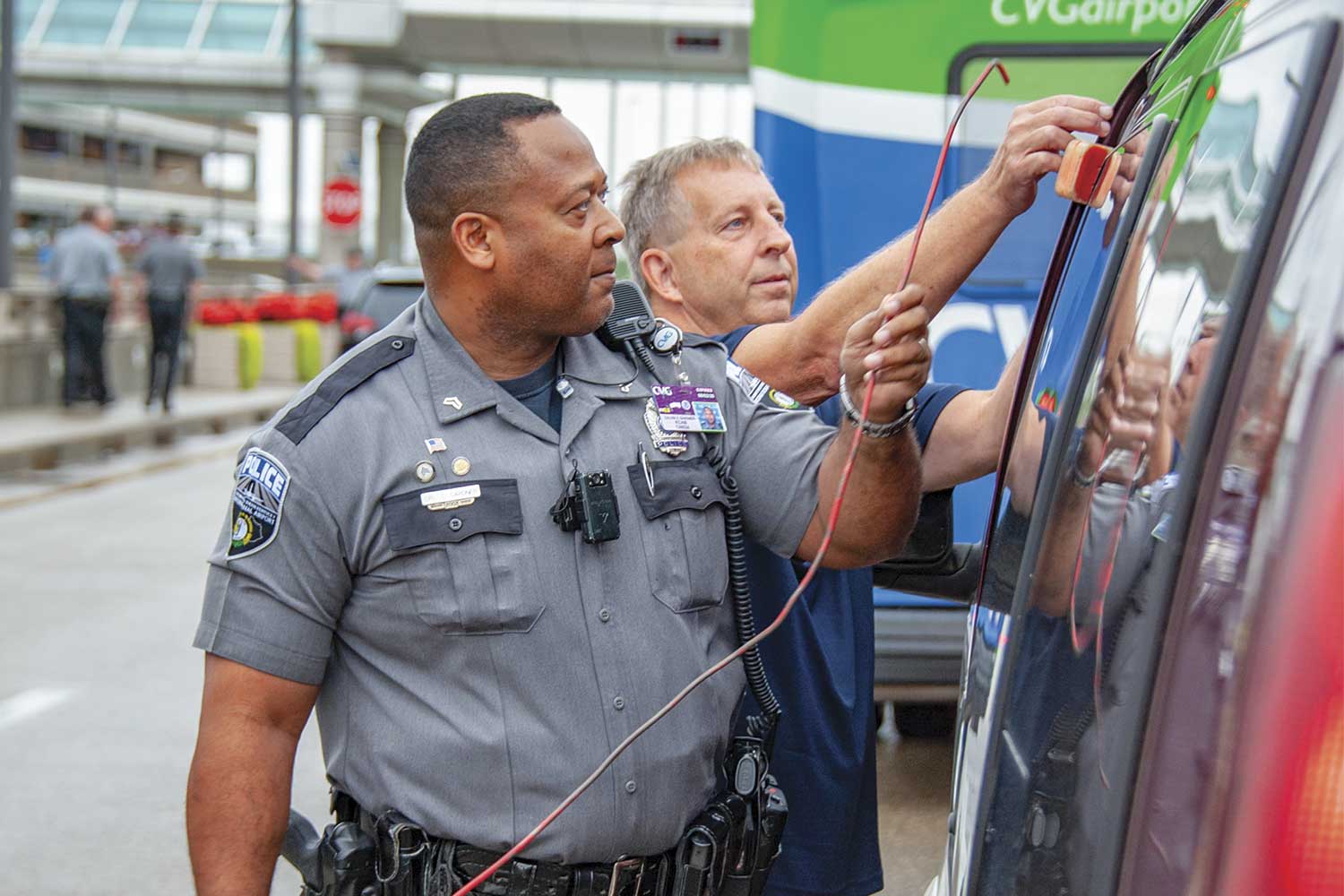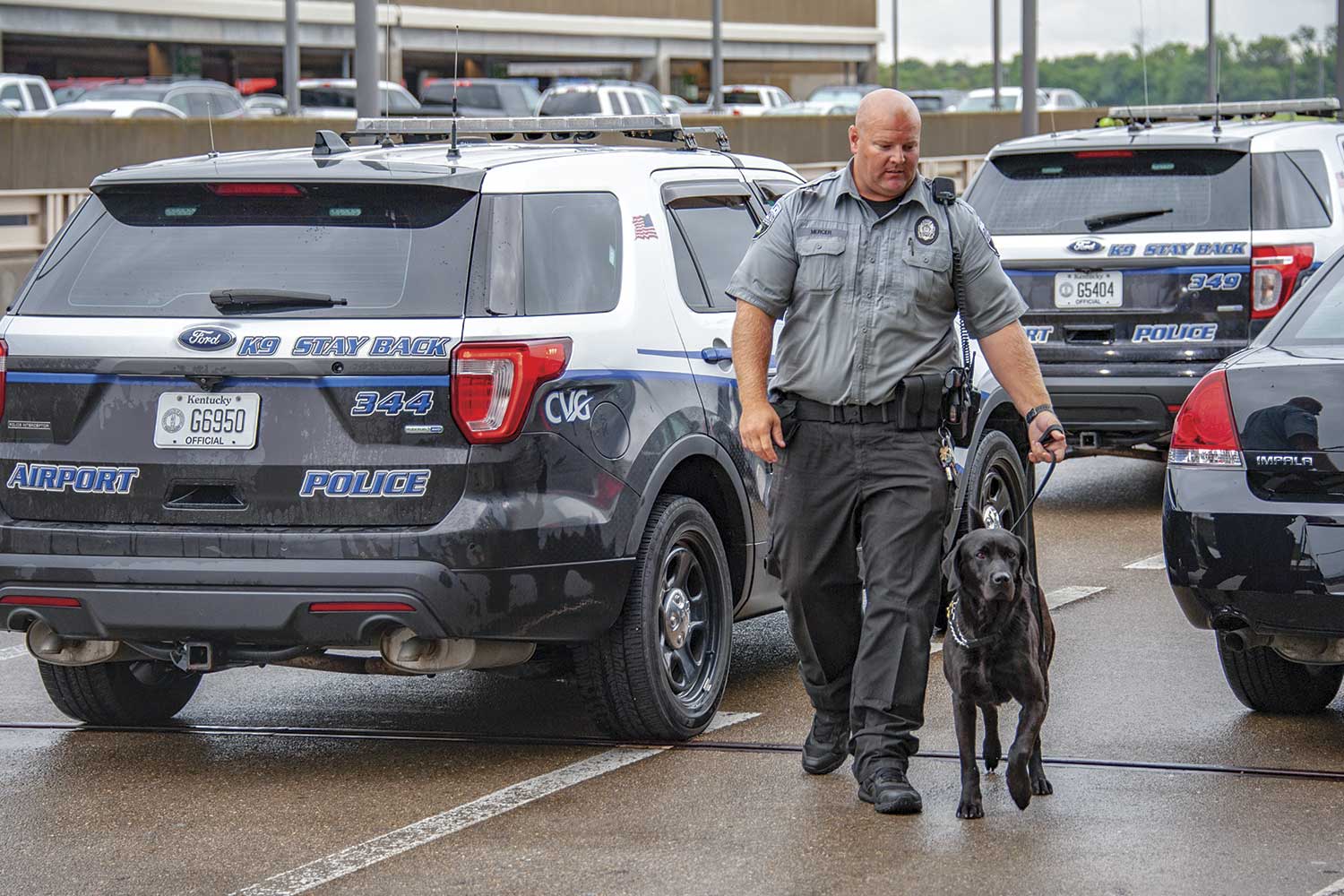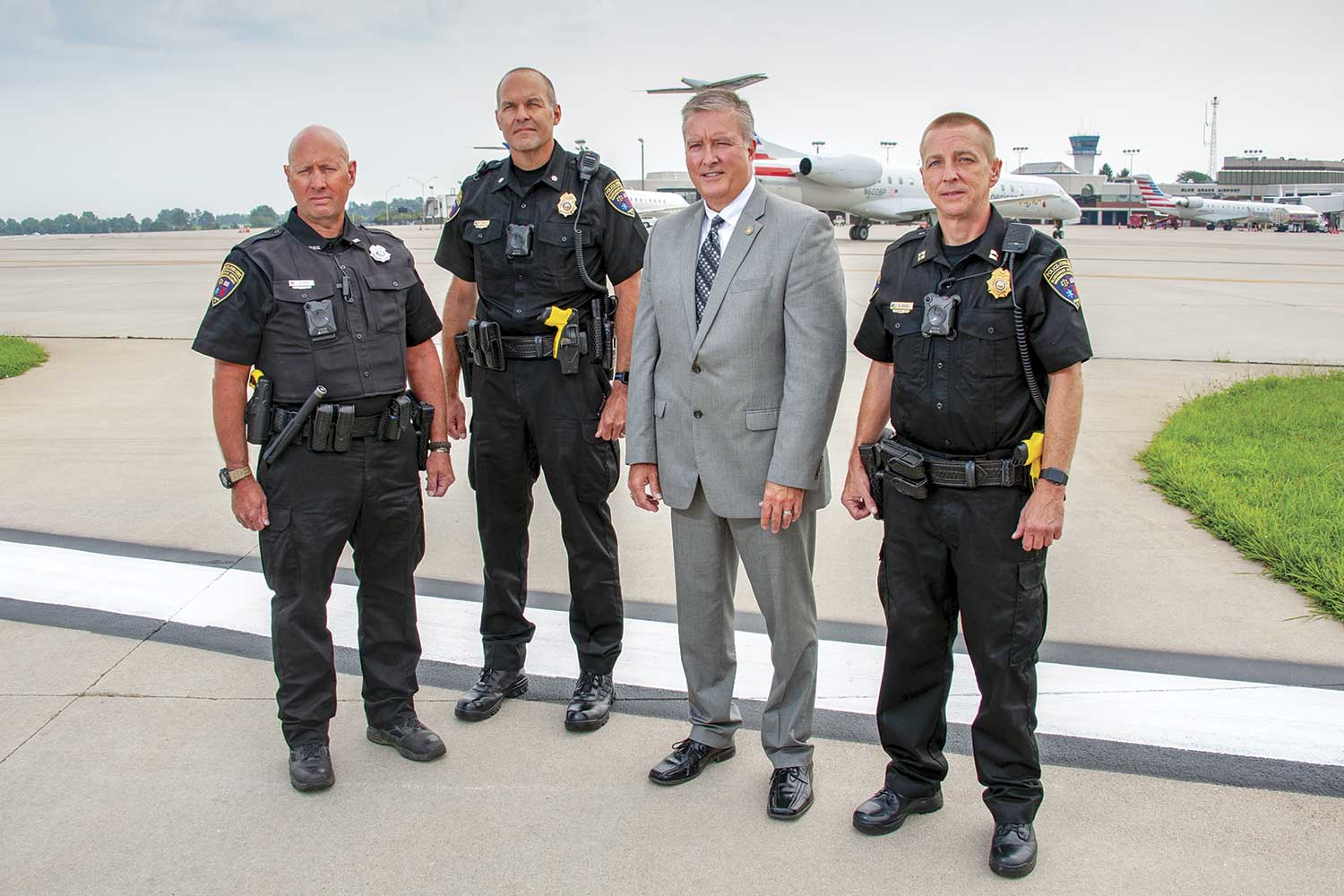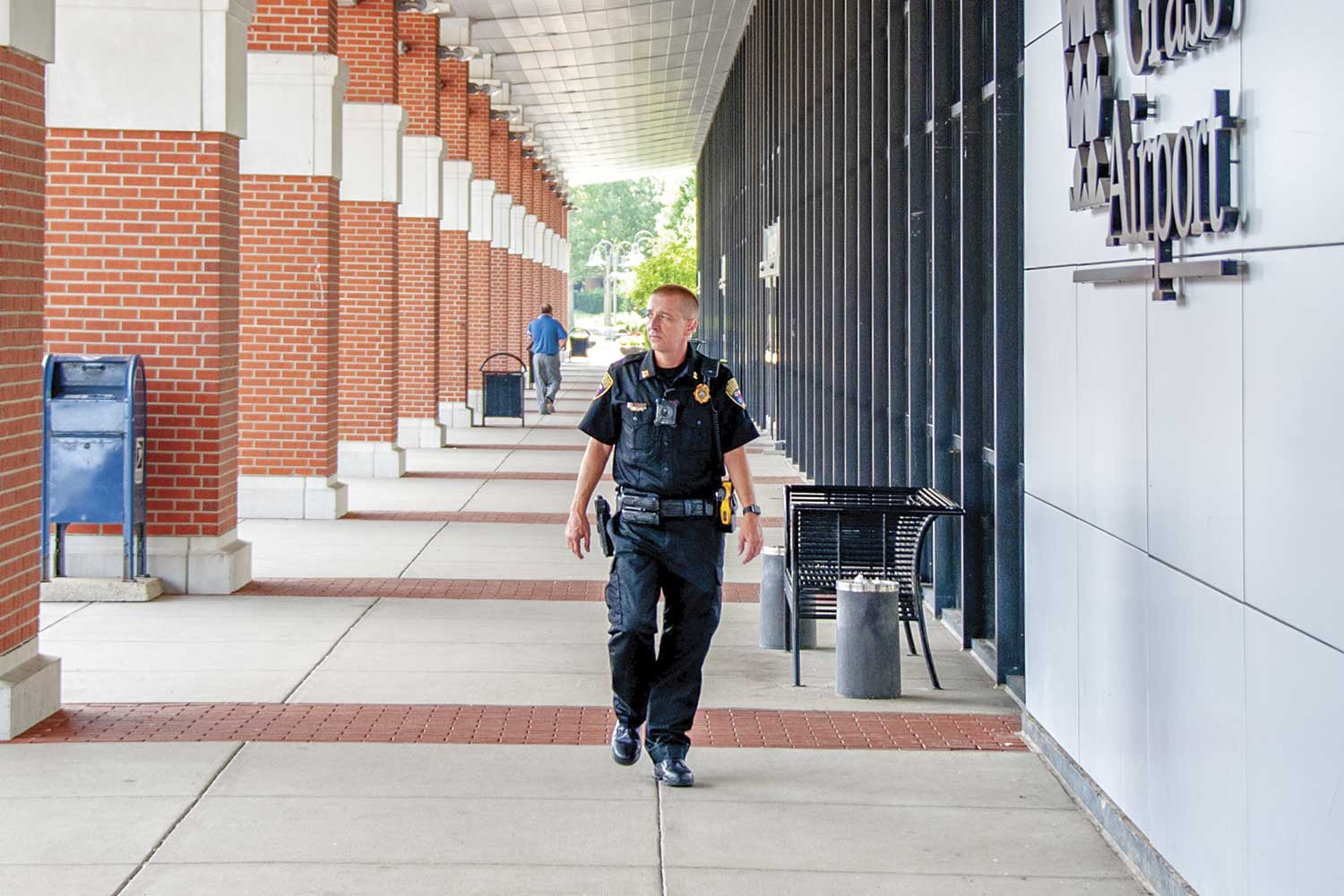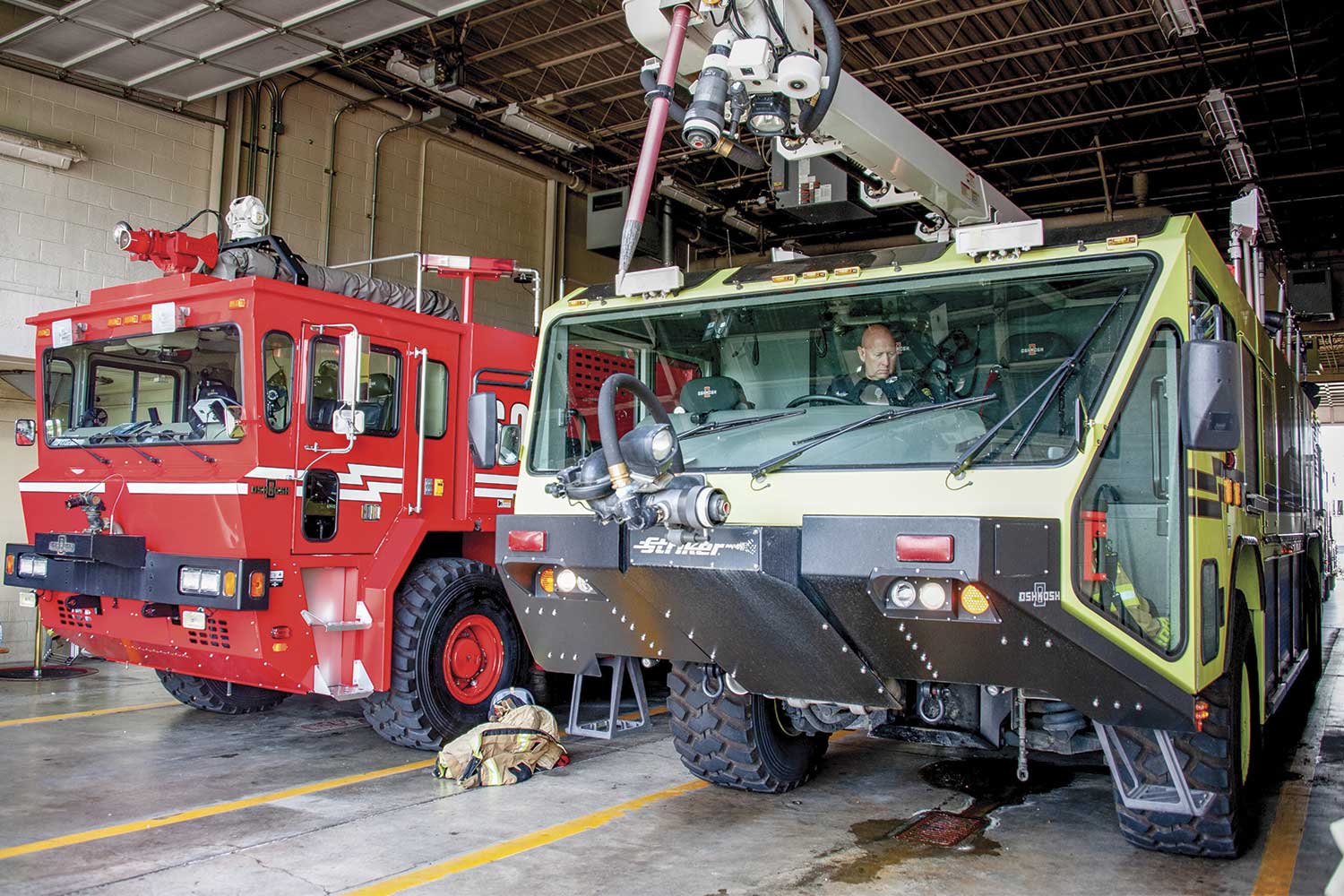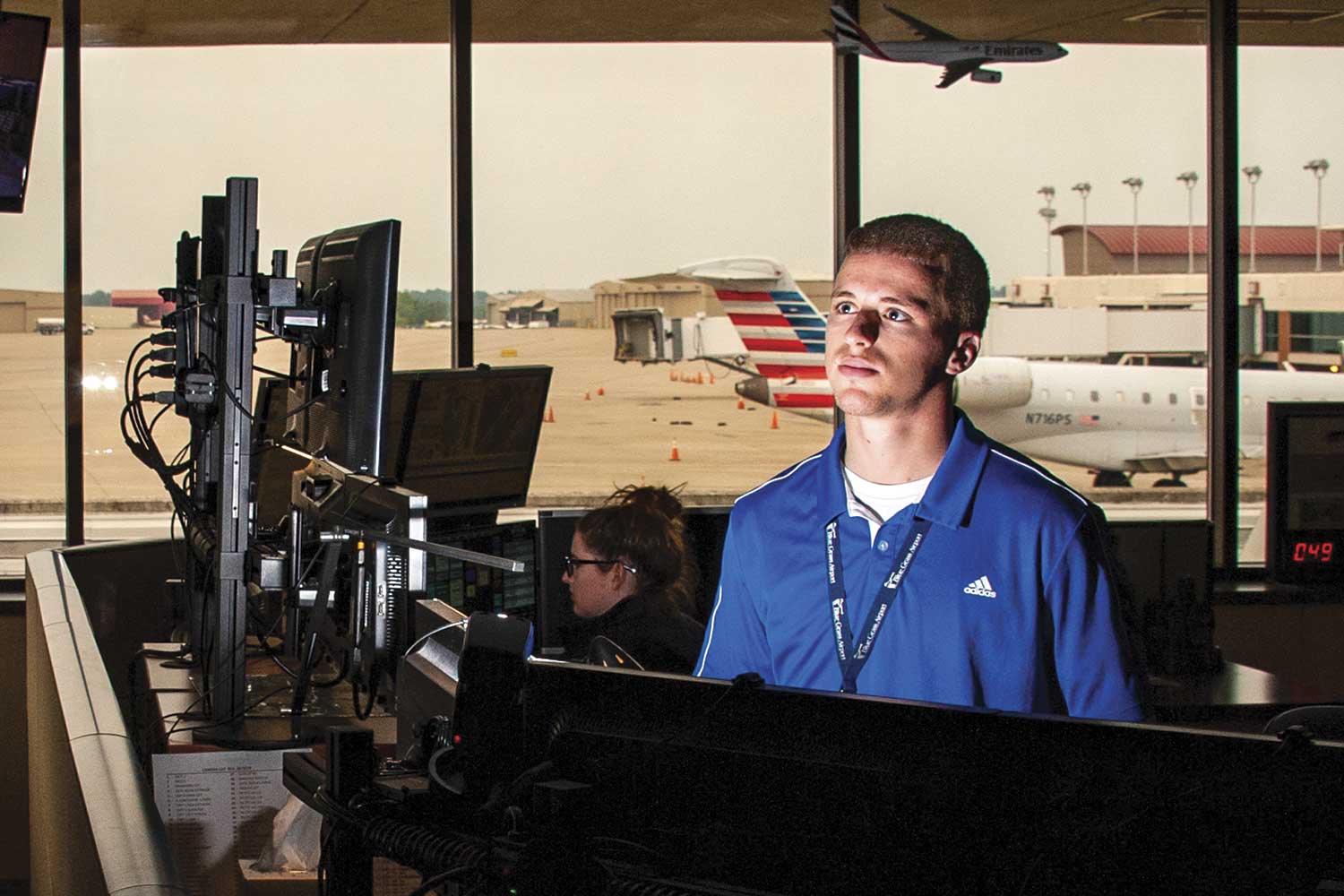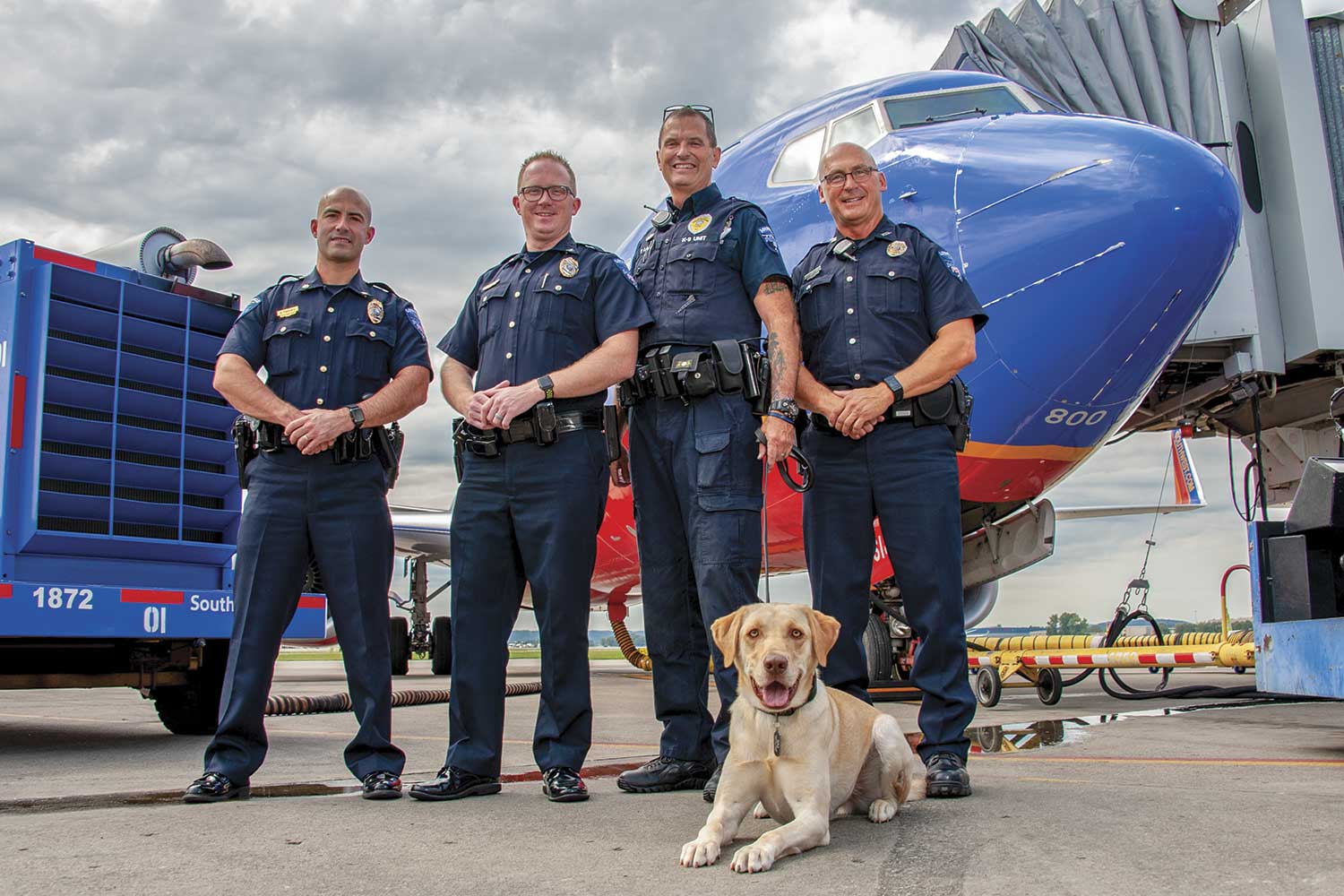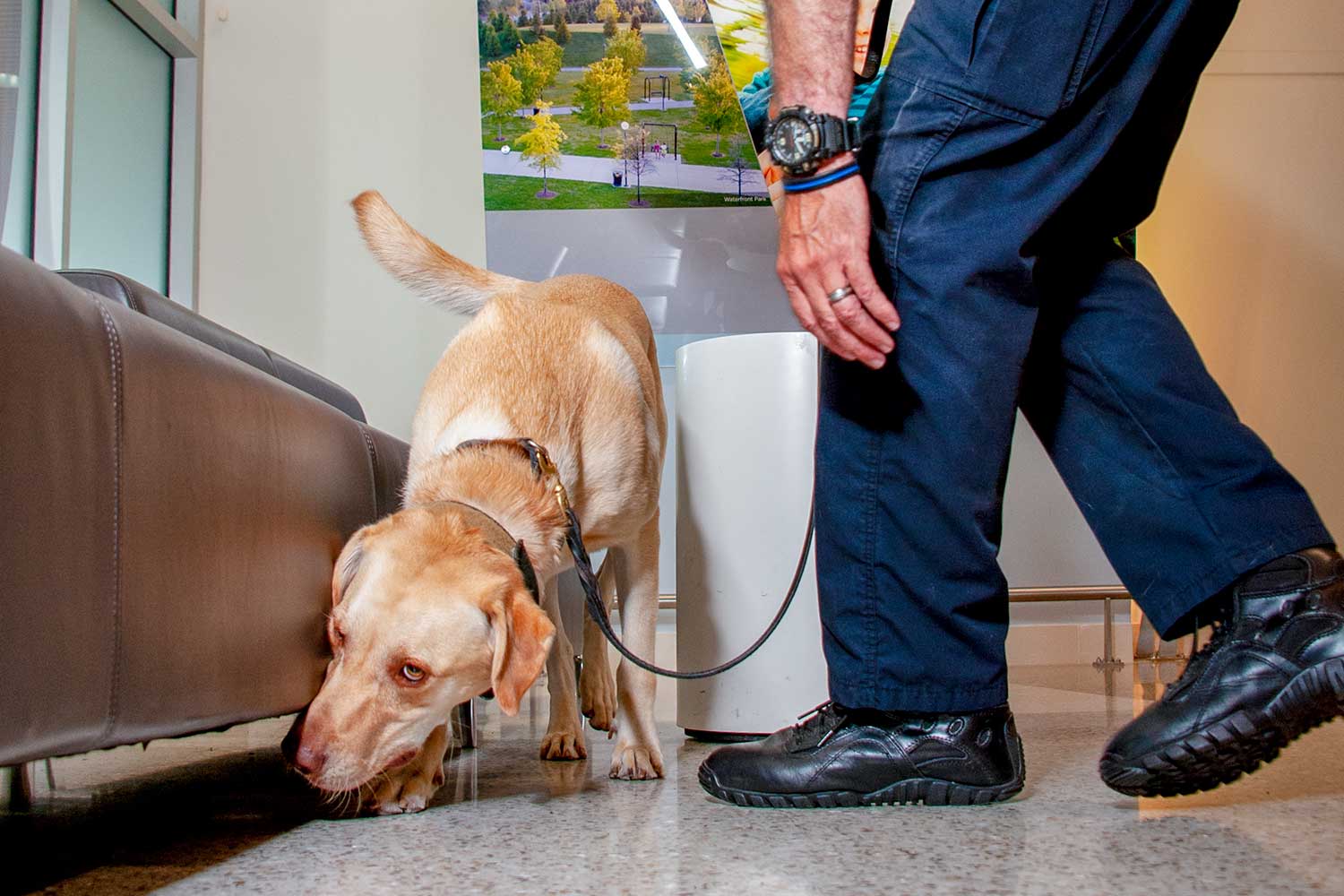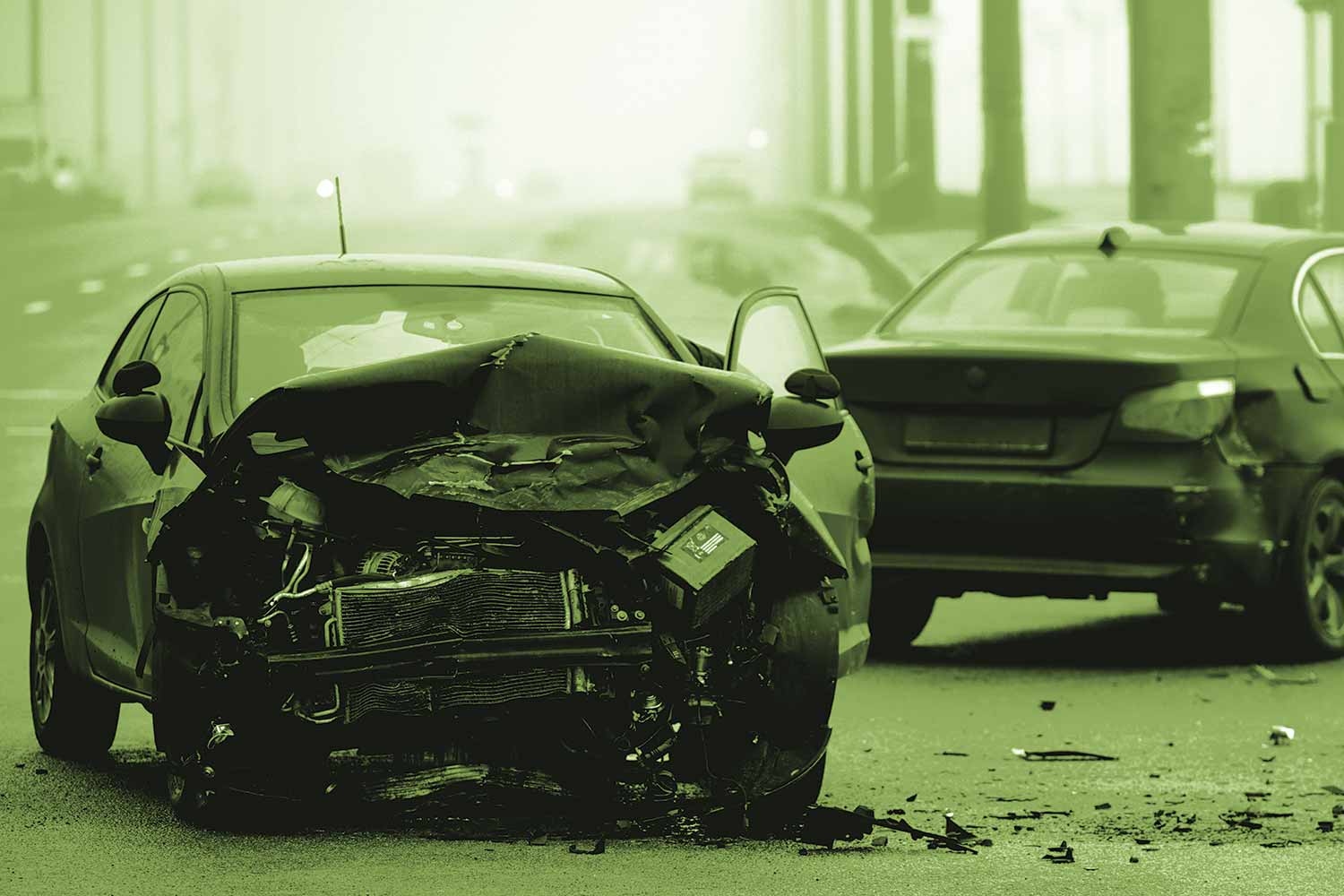Eyes in the Sky
The calls for service are much like what one would see in any police department or sheriff’s office: alcohol intoxication, thefts, drugs, car lockouts and domestic disturbances.
But airport police and public safety officers at Cincinnati-Northern Kentucky International Airport (CVG), Louisville International Airport and Blue Grass Airport face challenges beyond what a city or county law enforcement agency typically deals with.
One of the main challenges at Kentucky’s big three airports is an ever-changing population, as the airports see a combined 12 million people who fly in and out of the airports every year.
By comparison, Kentucky’s population is an estimated 4.3 million, according to the U.S. Census Bureau.
Diverse and Fluctuating Population
In every airport, officers are bound to interact with people from other countries, with different cultural backgrounds and belief systems.
“We just completed a diversity and inclusion course,” CVG Police Chief Shawn Ward said. “It is common that we deal with folks from different cultures and different parts of the world. All of our officers have a language line card, and if they know what language (the person is speaking), they can get someone on the phone who can speak and translate.”
With a high number of people coming and going through airports, repeat offenders are rare, which makes working in an aviation environment nice, Louisville Public Safety Director Josh Ball said.
“This job isn’t all rainbows and unicorns, but it’s a great environment,” Ball said. “I was a deputy in Bullitt County, just south of here, and when you deal with the same person over and over and over, or when you get the address, and you say, ‘Oh, I’m going to Kent’s place,’ you lose faith in humanity. It got to the point where I was miserable to be around. My family didn’t want me around, and Christmas was miserable. I came here, and I’ve dealt with the same person more than once. It was a homeless person who found a way into the airport.”
Many people utilizing airports often find themselves in need of basic information such as where a gate is located, directions to the nearest bathroom and the like.
Because of that, customer service plays a key role for law enforcement in an airport setting, according to Ward. For example, Ward said many agencies typically don’t provide car lockout services, but that isn’t the case at the CVG airport.
“We have lockout tools in our cars and many agencies don’t because of liability reasons,” Ward said.
Most of the people airport police deal with on a daily basis are those who are having a bad day and simply need to let off steam, Ball said.
“About 95 percent of the time, they go on their way,” he said. “The other 5 percent of the time, we find other arrangements for them.”
Blue Grass Airport Public Safety Director Scott Lanter said customer service, in many ways, is another means of community-oriented policing. When it comes to a new hire, Lanter said his agency is looking for someone with customer-service skills.
“When we’re hiring, we really try to drill down into the candidate and see if he or she is going to help that person who is having a bad day, and freaking out at a checkpoint, or who has lost their car in the parking lot,” Lanter said.
With that in mind, Lanter added that it’s a delicate balance between policing and customer service.
“When we train our folks, (customer service) is what we key in on, but we never let customer service water down our (law enforcement) skills,” Lanter said. “You always look through the law enforcement lens when you’re providing good customer service.”
At Louisville, the “on campus” population spikes at night, Ball said. That’s because more than 15,000 United Parcel Service (UPS) employees show up for work.
“We’re the third busiest cargo airport in North America and seventh largest in the world, and that’s because of UPS,” Ball said. “We tag team that with Louisville Metro; they have more resources than we do. We can actually go straight to the site, where they have to go through security and get escorted. It’s an ant farm (at UPS) at night. We go down there and they’re zipping across the (tarmac) and there are planes … we’re talking about 200 flights at night. To put it in perspective, we only have 76 passenger flights a day here.”
Police and Public Safety
In the event of a fire or medical emergency, Blue Grass and Louisville public safety officers don a different hat, one of firefighter and EMT.
“In aviation, it’s pretty prevalent,” Lanter said of adding other public safety duties to their law enforcement services. “There is a lot of training involved. We have to have 100 hours of fire training every year on top of the 40 hours of law enforcement training each year,”
To that end, some of the physical and training requirements are different from other law enforcement agencies.
“On the firefighter side of the house, there is the Candidate Physical Agility Testing – CPAT,” Lanter said. “It’s typical firefighting rescue requirements like climbing obstacles and moving large amounts of weight. So it checks your ability to do gross-motor functions and cardiovascular conditioning.”
Both Blue Grass and Louisville have modified their respective Field Training Officer (FTO) and Police Training Officer (PTO) training to incorporate the entire scope of public safety.
“Once (an officer) comes back from (DOCJT basic) training, they are put on FTO with a sergeant or field training officer,” Lanter said. “But it’s not just law enforcement FTO. It’s everything we would do at our job here – aircraft rescue, firefighting and EMS response.”
Once a public safety officer goes through the FTO program, they’ll work with the shift commander, he or she will take a written test and the entire platoon will evaluate them by sitting around a table and “firing off questions to them,” Lanter added.
Blue Grass and Louisville work shifts of 24-on and 48-off, which is a typical firefighter’s shift. During the 24-hour period, they perform all aspects of public safety – police, fire and EMS, Ball said.
But when it comes to the law enforcement side, Ball said the mission and tactics aren’t any different from other agencies.
“Our patrol duties resemble what most people think of a community-oriented police officer,” Ball said. “We’re patrolling for visibility. We do that for two reasons – deterrence and reassurance for our passengers.”
Criminal Element and Wildlife
Being a city within a city also means that airports have their fair share of bad guys, the chiefs said.
One of the biggest issues nationwide is rental car theft, Ward said.
“It’s challenging to get the rental-car companies on board so we can help them,” he said. “A lot of them have a fraud number they want to stay below, so as long as they’re below that number, they’re happy. One is too many for us, so we get a little antsy working those.”
In Louisville, Ball explained the agency is being proactive to try to curb the number of rental-car thefts.
“We’re looking at putting (rental cars) in a secured parking garage,” he said. “It’s not foolproof, but it gives our customers better service because they’re not standing out in the rain when they’re loading, and the cars are in a secure lot.”
Another means the three airports utilize to combat crime, in general, is simple communication. The three chiefs routinely meet and talk about common issues.
“It has helped us identify some trends, and once we identify the trends, we can disrupt them,” Ball said.
Aside from crime, wildlife can be troublesome, Ward said.
“We get coyotes, geese, deer and some others on the runways,” he said. “We have to ‘shoo’ them off or get rid of them for good … it depends on the circumstances.”
Louisville has a contract with the U.S. Department of Agriculture to help with the wildlife problem, but anything that occurs after business hours falls on the public safety officers, Ball said.
“We have different techniques,” Ball said. “The first one is a car horn. We also have a starter pistol that fires off bird bangers or bird screamers. One is a loud pop and the other is an ear-piercing scream. We will go to lethal force, if needed. The only thing exempt from the lethal force is a bald eagle. We can harass a bald eagle, but lethal force is not an option.”
Post 9/11
In the wake of world events, people are afraid of airports, and it all began on 9/11, Ward said.
“It changed everything,” Ward said. “Airport policing is much more susceptible to change due to world events; you can see something on the 6 o’clock news and it immediately affects us here.
“That is how it was post-9/11. We didn’t have Transportation Security Administration or Homeland Security,” Ward continued. “While all of that was taking shape, we dealt with the Federal Aviation Administration and its response to the threat we had all of a sudden.”
Lanter echoed Ward’s assessment.
“Prior to 9/11, we were running the roads looking for impaired drivers, speeding and a few drug cases here and there,” he said. “But 9/11 was a game-changer, and we brought our focus internally, initially, and now we’re trying to push it back out to keep the bad guys away from the terminal.”
Ultimately, the job of airport police and public safety officers is to keep the public safe, and Ball said it is something he stresses to his staff constantly.
“I tell (his officers) if someone takes a small explosive and detonates it in the empty cell-phone parking lot (a free lot dedicated to people who are waiting to pick someone up from the airport) and the only damage it does is to the asphalt … on the world news, it’s going to say, ‘A bomb exploded at the Louisville airport,’ Ball said. “That’s the mindset we have to be in. (Terrorists) don’t have to be successful in order to be successful. Our job is to be vigilant and be out on patrol and know what is going on and knowing what normal behavior is at the airport.”

